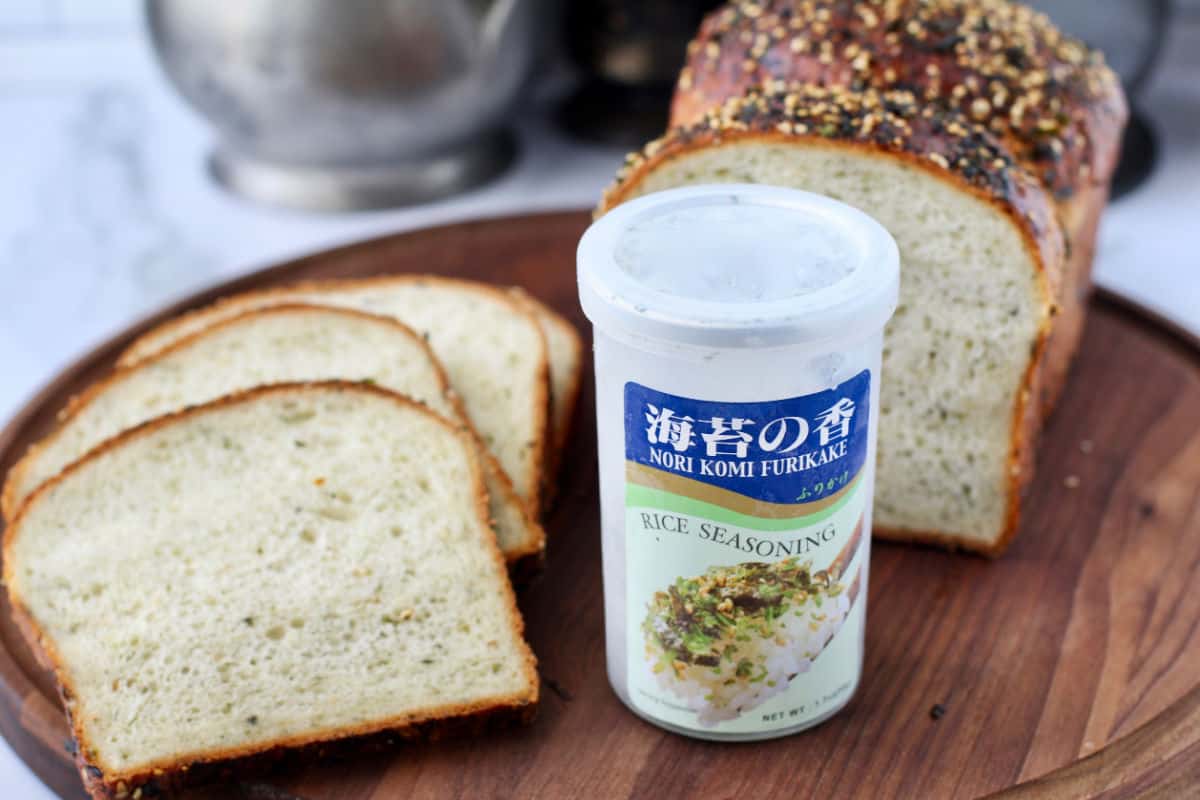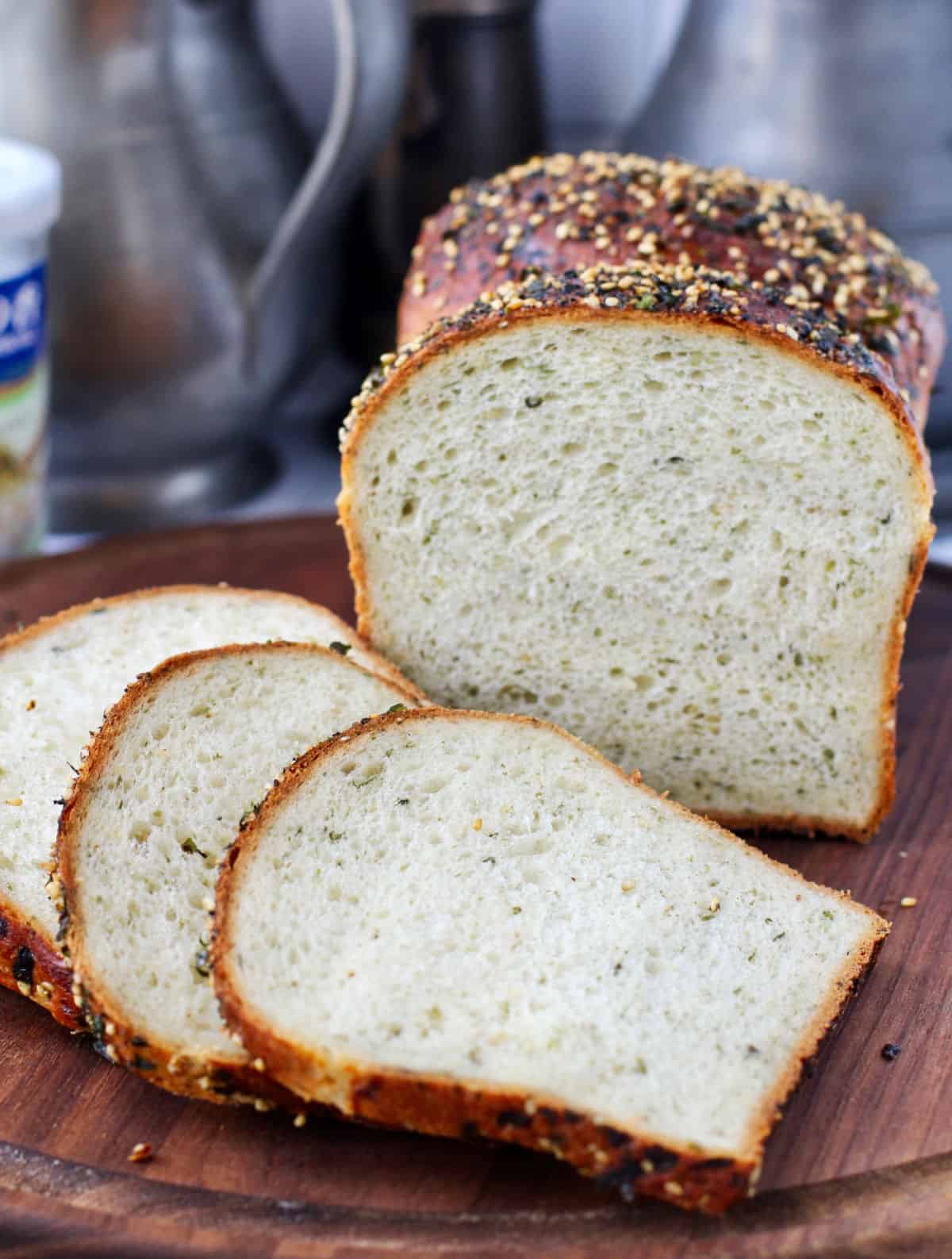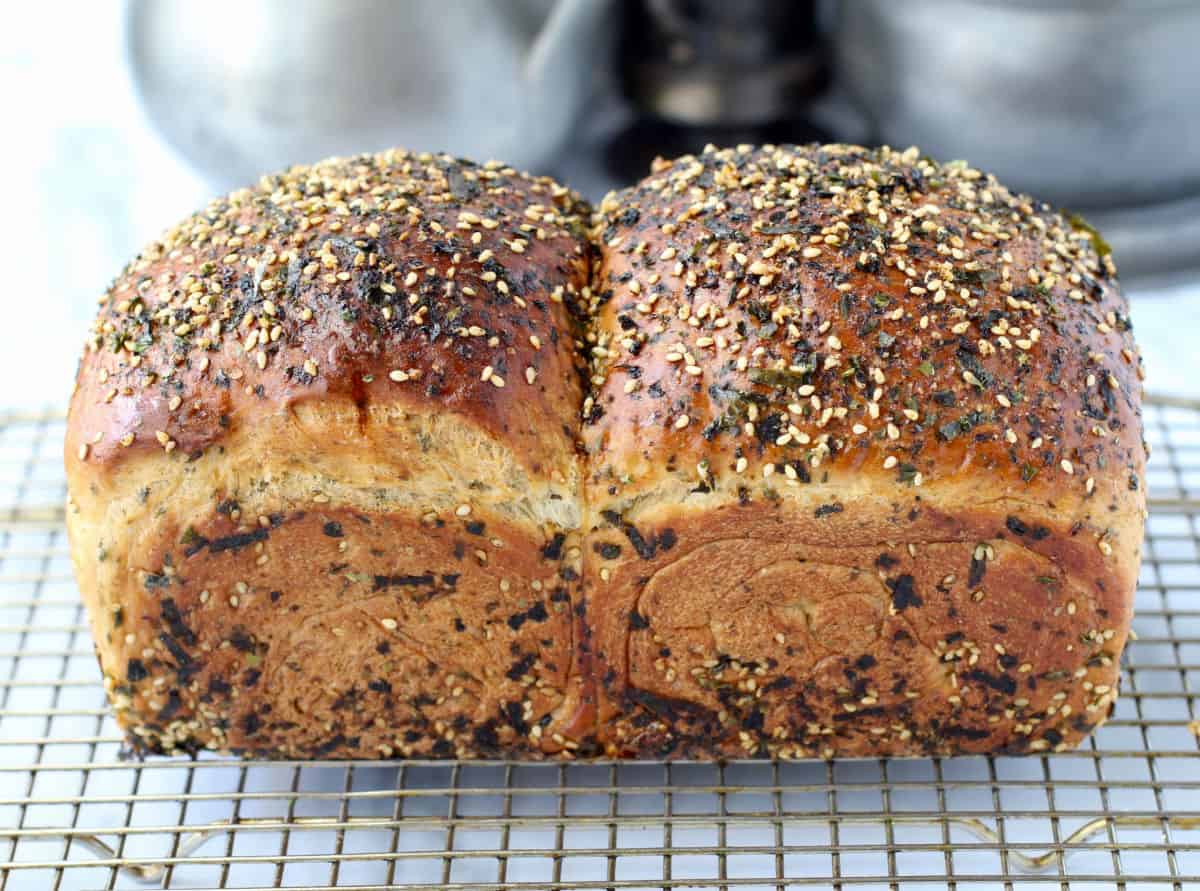This Japanese milk bread with furikake is a wonderfully soft loaf pan bread with added extra umami flavor from furikake, a Japanese seasoning.
This bread recipe is based on an Asian method for creating a super fluffy bread by cooking flour and water together to gelatinize the starches in the flour, making it super moisture absorbent. You can use more water in the dough without ending up with a super sticky, hard to handle dough.
With this bread, furikake, a blend of nori, sesame seeds, salt, and sugar, is added to the final dough and then is used for sprinkling over the top and sides of the shaped bread before baking. The furikake adds a wonderfully distinct umami flavor to this bread.
When I first tried this method for making bread in 2012, I've been fascinated with it. I've since tried it with sourdough, rye, and whole wheat and have been super happy with the results.
This furikake Japanese milk bread is incredibly soft and ethereal, the kind of bread where you can peel off layers like you might with French pastry... only these are softer.
To achieve such a soft bread, you cook flour and water together. This mixture is called a tangzhong.
What is Tangzhong?
A tangzhong is a mixture of flour and water that is cooked until the mixture thickens and gelatinizes, like a pudding. The ratio of flour to water is typically 1 to 4 or 1 to 5. The mixture is cooled and then mixed into the bread dough.
The tangzhong should be cooked until it reaches 149 degrees F, or 65 degrees celcius, and then removed from the heat. You transfer the mixture to a bowl and let it cool before adding it to the final dough.
Although the origins of this bread style is Japanese, the term "tangzhong" is Chinese. This style of bread has become very popular throughout both China and Japan.
You may also have heard of the term "yudane," which is the Japanese word for cooked flour and water. However, the process is slightly different, in that boiling water is poured over and stirred into flour, plus, the ratio of flour to water is 1:1 (source: America's Test Kitchen).
With this bread, I've used the tangzhong method.
More About Furikake:
Furikake is a Japanese seasoning used on rice, vegetables, and sometimes seafood. I've used it on take-out sushi before.
It's an ingredient that I first bought to make Japanese rice crackers (senbei), and have since used as a seasoning, even for deviled eggs! It's fairly easy to find in the Asian section of your grocery store. There are several flavors available. The one I used for this bread is Nori Komo Furikake, which consists of nori, sesame seeds, sugar, and salt.
There are flavors that include dried bonito, shrimp, wasabi, or other flavors which are worth a try too! You can even make your own with crushed nori sheets, toasted sesame seeds, sea salt, and some sugar.
The shaping method for this bread involves rolling the dough out into a long rectangle, dividing it in half lengthwise, and then rolling up each piece into a cyllinder, like a snail.
To coat the loaf on all sides with the furikake, spray an 8 1/2 inch by 4 1/2 inch loaf pan with spray oil and then coat the sides and bottom with the furikake. Once you've shaped the loaf and put it in the pan, and let it rise, brush it with an egg wash and sprinkle the top with more furikake.
This bread is finished with a light brushing of sesame oil after baking for even more amazing flavor. This bread is fantastic spread with salted butter. It's also fabulous for tuna or grilled cheese sandwiches.
I totally recommend exploring the world of Japanese and Asian breads. They are a lot of fun to make, delicious, and totally fluffy, moist, and will stay fresh a lot longer.
Best Breads
- Gifts in a Jar: One Hour Whole Wheat Bread from That Recipe
- Homemade Garlic and Herb Swirl Bread from Blogghetti
- Japanese Milk Bread with Furikake from Karen's Kitchen Stories
- Sourdough Charcuterie Flatbread from A Kitchen Hoor's Adventures
We share Recipes From Our Dinner Table! Join our group and share your recipes, too! While you're at it, join our Pinterest board, too!
Japanese Milk Bread with Furikake

Ingredients
- 25 grams (7/8 ounces / 3 tablespoons) bread flour
- 1/2 cup water
- 1/2 cup cold whole milk
- 1 large egg
- All of the Tangzhong
- 1 1/2 teaspoons instant yeast
- 287 grams (10 1/8 ounces / 2 cups) bread flour
- 6 tablespoons furikake, divided
- 2 tablespoons granulated sugar
- 1 1/2 teaspoons salt
- 3 tablespoons unsalted butter, softened
- 1 large egg, beaten with 1 tablespoon water and a pinch of salt
- 1 tablespoon toasted sesame oil
Instructions
- Cook the flour and water in a small saucepan over medium low heat, whisking constantly, until the mixture reaches 149 degrees F and the mixture is pudding-like.
- Remove the pan from the heat and scrape the mixture into a small bowl to cool.
- In the bowl of a stand mixer, whisk together the milk, egg, and tangzhong until thoroughly combined. Add the yeast and the flour and mix with the dough hook on low speed for about two minutes. Cover the bowl and let rest for 15 minutes.
- Add 3 tablespoons of the furikake, the sugar, and salt and mix on low for about five minutes. Add the butter, one tablespoon at a time, incorporating each piece before adding the next one. Once each is incorporated, mix on medium speed for 7 to 9 minutes, until the dough is elastic.
- Turn the dough out onto your work surface and form it into a ball. Place it into an oiled bowl or dough rising bucket, cover, and let rise until doubled, about 60 to 90 minutes.
- Spray a 8 1/2 by 4 1/2 inch loaf pan with spray oil. Place 2 tablespoons of the furikake in the pan and turn the pan until the bottom and sides are coated.
- Turn the dough out onto your work surface and roll it out into a 24 inch by 4 inch rectangle. Using a pizza cutter to cut it in half lengthwise.
- Roll up each half into a coil and place each, seam side down, into the pan with the spiral sides on the long side of the pan (like two snails).
- Cover with oiled plastic wrap and let rise until the dough rises to the top of the pan.
- In the meantime, heat your oven to 375 degrees F with a rack on the lower third level.
- Brush the top of the loaf with the egg wash and sprinkle with the remaining furikake.
- Bake the loaf for 30 to 35 minutes, until golden brown and the bread reaches 205 degrees F. Let the loaf cool in the pan on a wire rack for 15 minutes. De-pan the loaf to the rack and brush the top and sides with the sesame oil. Let cool completely before slicing.
Nutrition Facts
Calories
125Fat (grams)
4 gSat. Fat (grams)
2 gCarbs (grams)
19 gFiber (grams)
2 gNet carbs
17 gSugar (grams)
3 gProtein (grams)
4 gCholesterol (grams)
18 mgRecipe adapted from The Savory Baker: 150 Creative Recipes, from Classic to Modern.










Oh wow, Karen, this bread sounds amazing. I never have had milk bread before, must give it a try.
ReplyDeletecan the Japanes milk bread be made in a bread machine ????
ReplyDeleteI haven't tried it, but the kneading part would probably work, but not the shaping part.
DeleteMy mother gave me some furikake once. That's when I realized I do not like seaweed. LOL This milk bread look absolutely tender and delicious!
ReplyDeleteJust skip the furikake!
DeleteI have really been loving the texture of milk breads lately!
ReplyDeleteThank you!
DeleteThis bread is so pretty! I have never had milk bread before. I think I need to add it to my must make list (Jennifer sikora)
ReplyDeleteThis sounds SO delicious and it looks gorgeous! Everything is perfect and I love the way you have used furikake in this loaf.
ReplyDeletei use milk instead of water to make the tangzhong
ReplyDeleteI've done it both ways.
Delete